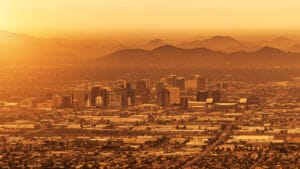Perched on the threshold of economic recovery, cities whose housing markets crashed and burned during the Great Recession are struggling like modern-day Phoenix birds to rise from the ashes.
While rebirth comes naturally for some, others seem caught between a trap labeled “sprawl” and a wide-open window tagged “sustainability.”
The question is, can cities that once embraced policies favoring sprawl over density buy into a new vision calling for a more sustainable, livable and socially just way of life? The shift required may be dramatic, but it’s not impossible.
The sprawl trap is certainly familiar territory for Phoenix, a post-WWII boom town where production builders John F. Long and Del Webb are hailed as the Godfathers of Post-Modern Development. Using innovations like simple, mass-production construction techniques, Long and Webb delivered Phoenix’s first work force housing to an eager middle-class audience.
Now, a half-century later, sprawl and the suburbs are being blamed for everything from global warming to social segregation. High suburban-growth states like Arizona, California, Nevada and Florida felt the busted housing bubble like a sock to the gut two years ago. And, faced with aging infrastructure and higher maintenance costs, fringe communities are now home to the country’s largest and fastest growing poor population, according to a report by the Brookings Institution. Between 2000 and 2008, the country’s largest metro areas saw their poor population grow by 25 percent, almost five times faster than either primary cities or rural areas, the report states.
Many economists believe the country’s latest economic pause presents the opportunity for a massive do-over; a chance for cities to end their love affair with the automobile and hook up, instead, with development practices that create more dense, walkable neighborhoods.
The Obama administration evidently agrees.
“The days where we’re just building sprawl forever, those days are over,” President Obama declared shortly after taking office. He followed up those remarks earlier this year by telling the U.S. Conference of Mayors, “When it comes to development, it’s time to throw out old policies that encouraged sprawl and congestion, pollution, and ended up isolating our communities in the process.”
The President’s willingness to back up his convictions with $1.5 billion in TIGER (Transportation Investment Generating Economic Recovery) grants and $1 million set aside for regional integrated planning initiatives is further proof that the suburban landscape is indeed changing. So is the federal government’s new Partnership for Sustainable Communities, an all-hands-on-deck approach to smart growth by the Department of Transportation, the Department of Housing and Urban Development and the Environmental Protection Agency. It — along with the government’s “Smart Growth Guidelines for Sustainable Design & Development” — presents a radical new perspective on how future growth is handled, and offers a lifeline to municipalities looking to turn over a new and greener leaf.
But, for cities like Phoenix, where density has traditionally been considered a dirty word, the challenge is not so much where the money is coming from, as it is how to change public perception. Will Phoenix, with its Wild West sensibilities and traditionally renegade attitude, take kindly to federal intervention intended to help wean itself from a dependence on sprawling development?
In all honesty, it’s likely to be a tough sell. True, infill development takes advantage of current infrastructure and services and produces a measurably smaller environmental impact than does its conventional counterpart. True, higher-density building creates additional living options for homeowners in the way of row houses, walk-ups and brownstones. And true, Phoenicians, like many Americans, acknowledge they would rather walk than drive, or at the very least, have access to more transit-oriented housing, making it easier and more convenient for them to utilize public transportation.
The first step forward, however, will have to come from developers and municipal leaders willing to reach out a hand and grab the support line being offered in the way of these new smart-growth initiatives and incentives.
“Successfully addressing the challenges and opportunities of growing smarter and building greener will require that communities collaborate with each other, as well as with regional, state and federal agencies and organizations,” write the authors of Smart Growth Guidelines for Sustainable Design & Development. The end reward, they say, is decisions that benefit households in the form of greater choice, lower combined housing and transportation costs and healthier communities, thereby producing stronger local economies.
Isn’t that what communities like Phoenix, that are battling their way out of the recession, really need? Shelley Poticha, a transportation reformer and Partnership for Sustainable Communities senior adviser, thinks so.
“To me this is about helping to rebuild our economy, about growing jobs in terms of making housing more energy-efficient,” she said in a grist.org interview. “It’s also about helping places and regions really understand where their economic future is going and how they can use that to be more sustainable.”



